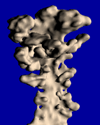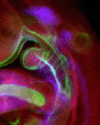Fluorescence Imaging
The original intention was to create an optical equivalent of CT scans, in which light is transmitted through the specimen and absorbed by the tissue. However, we quickly realised the potential power of using fluorescence imaging, as it would allow us to reconstruct the distributions of multiple signals within the same specimen. In this scenario, the imaging operates through the use of a standard fluorescence dissecting microscope. The signal obtained can be reconstructed using only slight modifications to the back-projection algorithm. .
|
Structure of the developing pancreas, as visualised by fluorescence immunohistochemistry of E-Cadherin (specimen prepared by Ulf Ahlgren) |
|
Fluorescent double-staining of whole embryos, to analyse the distributions of two expression patterns in the same specimen (specimen prepared by Ulf Ahlgren) |






